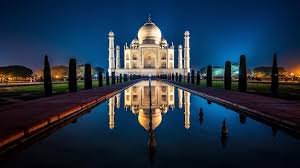The Taj Mahal is one of the most iconic and recognizable structures in the world, renowned for its stunning beauty and intricate design. Located in Agra, India, it was commissioned by the Mughal emperor Shah Jahan in 1632 in memory of his favorite wife, Mumtaz Mahal, who died during childbirth. The Taj Mahal is widely regarded as the finest example of Mughal architecture, which blends elements from Islamic, Persian, Ottoman Turkish, and Indian architectural styles.

Architecture and Design
The Taj Mahal is constructed primarily of white marble, which gives it a radiant, almost ethereal appearance, especially under different lighting conditions. The monument stands on a square platform with a large central dome that rises about 73 meters (240 feet). The four minarets at each corner of the platform are slightly tilted outward to prevent them from collapsing on the main structure in the event of an earthquake.

The main building houses the tombs of Mumtaz Mahal and Shah Jahan. However, the sarcophagi inside the mausoleum are only symbolic, as the actual graves lie in a lower level of the structure. The interior of the Taj Mahal is decorated with intricate calligraphy, inlays of semi-precious stones (known as pietra dura), and elaborate carvings depicting floral patterns.
Gardens and Complex
The Taj Mahal is set in a large Mughal garden, which is designed in the charbagh (four-plot) style, symbolizing the paradise described in Islamic texts. A long reflective pool runs through the center, perfectly mirroring the monument, adding to its symmetrical beauty. The complex also includes a mosque and a guest house made of red sandstone.

Symbolism and Legacy
Often described as a “monument of love,” the Taj Mahal symbolizes eternal love and devotion. Its construction took over 20 years and involved thousands of artisans. The structure has become a UNESCO World Heritage Site and is considered one of the New Seven Wonders of the World.
Cultural Significance
The Taj Mahal is a symbol of India’s rich history and architectural brilliance. It attracts millions of visitors annually and serves as an emblem of India’s cultural and historical heritage. Its beauty and craftsmanship have made it an enduring source of inspiration for poets, artists, and travelers worldwide.

